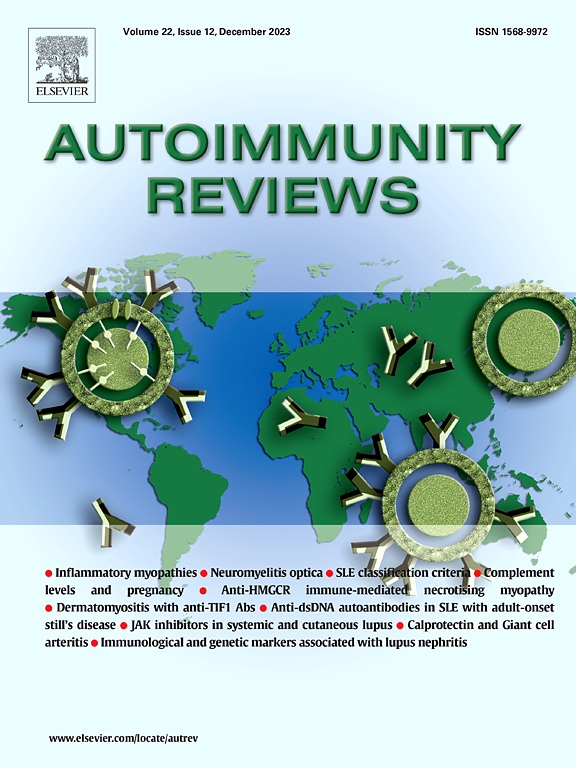Rebalancing redox homeostasis: A pivotal regulator of the cGAS-STING pathway in autoimmune diseases
IF 8.3
1区 医学
Q1 IMMUNOLOGY
引用次数: 0
Abstract
Autoimmune diseases (ADs) arise from the breakdown of immune tolerance to self-antigens, leading to pathological tissue damage. Proinflammatory cytokine overproduction disrupts redox homeostasis across diverse cell populations, generating oxidative stress that induces DNA damage through multiple mechanisms. Oxidative stress-induced alterations in membrane permeability and DNA damage can lead to the recognition of double-stranded DNA (dsDNA), mitochondrial DNA (mtDNA) and micronuclei-DNA (MN-DNA) by DNA sensors, thereby initiating activation of the cyclic GMP-AMP synthase-stimulator of interferon genes (cGAS-STING) pathway. While previous reviews have characterized cGAS-STING activation in autoimmunity, the reciprocal regulation between redox homeostasis and cGAS-STING activation remains insufficiently defined. This narrative review examines oxidative stress-mediated DNA damage as a critical driver of pathological cGAS-STING signaling and delineates molecular mechanisms linking redox homeostasis to autoimmune pathogenesis. Furthermore, we propose therapeutic strategies that combine redox restoration with the attenuation of aberrant cGAS-STING activation, thereby establishing a mechanistic foundation for precision interventions in autoimmune disorders.
Methods
The manuscript is formatted as a narrative review. We conducted a comprehensive search strategy using electronic databases such as PubMed, Google Scholar and Web of Science. Various keywords were used, such as "cGAS-STING," "Redox homeostasis," "Oxidative stress," "pentose phosphate pathway," "Ferroptosis," "mtDNA," "dsDNA," "DNA damage," "Micronuclei," "Reactive oxygen species," "Reactive nitrogen species," "Nanomaterial," "Autoimmune disease," "Systemic lupus erythematosus," "Type 1 diabetes," "Rheumatoid arthritis," "Multiple sclerosis," "Experimental autoimmune encephalomyelitis," "Psoriasis," etc. The titles and abstracts were reviewed for inclusion into this review. After removing duplicates and irrelevant studies, 174 articles met inclusion criteria (original research, English language).
再平衡氧化还原稳态:自身免疫性疾病中cGAS-STING通路的关键调节因子
自身免疫性疾病(ADs)是由于机体对自身抗原的免疫耐受被破坏而引起的病理性组织损伤。促炎细胞因子的过度产生破坏了不同细胞群的氧化还原稳态,产生氧化应激,通过多种机制诱导DNA损伤。氧化应激诱导的膜通透性改变和DNA损伤可导致DNA传感器对双链DNA (dsDNA)、线粒体DNA (mtDNA)和微核DNA (MN-DNA)的识别,从而启动干扰素基因环GMP-AMP合成酶刺激因子(cGAS-STING)通路的激活。虽然先前的综述已经描述了cGAS-STING在自身免疫中的激活,但氧化还原稳态和cGAS-STING激活之间的相互调节仍然没有得到充分的定义。这篇叙述性综述研究了氧化应激介导的DNA损伤作为病理性cGAS-STING信号传导的关键驱动因素,并描述了将氧化还原稳态与自身免疫发病机制联系起来的分子机制。此外,我们提出了结合氧化还原恢复和衰减异常cGAS-STING激活的治疗策略,从而为自身免疫性疾病的精确干预奠定了机制基础。方法采用叙述性综述的形式。我们使用PubMed、b谷歌Scholar和Web of Science等电子数据库进行了全面的搜索策略。使用了各种关键词,如“cGAS-STING”、“氧化还原稳态”、“氧化应激”、“戊糖磷酸途径”、“上铁”、“mtDNA”、“dsDNA”、“DNA损伤”、“微核”、“活性氧物种”、“活性氮物种”、“纳米材料”、“自身免疫性疾病”、“系统性红斑狼疮”、“1型糖尿病”、“类风湿关节炎”、“多发性硬化症”、“实验性自身免疫性脑脊髓炎”、“牛皮癣”等。对标题和摘要进行审查以纳入本综述。在剔除重复和不相关研究后,174篇文章符合纳入标准(原始研究,英语)。
本文章由计算机程序翻译,如有差异,请以英文原文为准。
求助全文
约1分钟内获得全文
求助全文
来源期刊

Autoimmunity reviews
医学-免疫学
CiteScore
24.70
自引率
4.40%
发文量
164
审稿时长
21 days
期刊介绍:
Autoimmunity Reviews is a publication that features up-to-date, structured reviews on various topics in the field of autoimmunity. These reviews are written by renowned experts and include demonstrative illustrations and tables. Each article will have a clear "take-home" message for readers.
The selection of articles is primarily done by the Editors-in-Chief, based on recommendations from the international Editorial Board. The topics covered in the articles span all areas of autoimmunology, aiming to bridge the gap between basic and clinical sciences.
In terms of content, the contributions in basic sciences delve into the pathophysiology and mechanisms of autoimmune disorders, as well as genomics and proteomics. On the other hand, clinical contributions focus on diseases related to autoimmunity, novel therapies, and clinical associations.
Autoimmunity Reviews is internationally recognized, and its articles are indexed and abstracted in prestigious databases such as PubMed/Medline, Science Citation Index Expanded, Biosciences Information Services, and Chemical Abstracts.
 求助内容:
求助内容: 应助结果提醒方式:
应助结果提醒方式:


